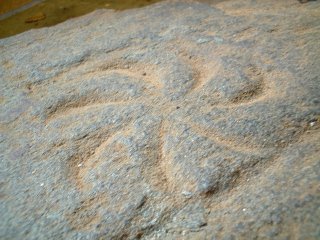
Ballantrae is a small village in the far south of Ayrshire and - sometimes - an excellent source of the driftwood that my husband often uses in his artworks. We went down there yesterday on a fine afternoon, but winter and spring, after the storms, are much the best seasons for driftwood and now most of it has been cleared away by the council, so that the visitors won't be hindered as they amble along the beach. Ballantrae was once a thriving fishing village, with many ring netters and other boats, with the characteristic BA registration. There is a village street which more or less turns its back on the sea, a ruined castle and a picturesque harbour, with only a few tiny boats moored there. Down along the shore is a lovely little row of fishermen's cottages which have been renovated and painted in bright colours, and an old clinker built open fishing boat, drawn up on the hard. This is a beach where terns nest and from which you have views of Ailsa Craig, now a bird sanctuary, and Arran, from an unusual angle, with Holy Isle clearly visible as a separate island (It sits in Lamlash Bay and from most of the Ayrshire coast, it looks as though it is part of the main island.) On a clear day, you can see the Kintyre Peninsula, and the Antrim coastline from here and it becomes very easy to see why the so called Scottii, the Dalriadan celts, came over from Ireland to colonise this place. Yesterday though, it was all misty and distant with smudgy suggestions of other lands. The only people on the beach were two women, walking a pair of dogs, and a couple of wee boys and a girl, who had set up sea fishing rods and were hoping for big things. Children in this part of the world have summers that most city kids can only dream of. There's an optimum time, my own grown-up son tells me, when you are 'old enough to go out and about on your own and young enough to get away with it.' He remembers playing 'chases' up hill and down dale, like the legendary William Brown and his outlaws, and already thinks about that time with a certain amount of nostalgia.
Down at the harbour, a retired couple who had driven down from nearby Girvan, were perched on the sea wall enjoying the sun, while a trio of teenagers with rods were digging for lugworms for bait. We stood back, older and wiser, and agreed that they hadn't a hope. They were digging and then standing back to survey the results, thus giving the worms plenty of time to burrow back in. The technique is to dig, and then pounce on them immediately. We spent a few summer mornings in Gigha, doing just that, when our son was small but I can't recall that we ever caught many fish. It was my dad who was the lucky fisherman.
At Ballantrae, we poked about the beach for a while, gathering one or two interesting driftwood pieces, which might be useful as part of something larger, and then came home again. In due course, you might well see some of the results of our beachcombings on the Scottish Home. Driftwood is imported into the UK in huge quantities these days, but there is nothing quite like the natural sculptures to be made from the real, indigenous product. And if you aren't sculpturally inclined, these sea bleached pieces can still make an interesting addition to your garden.








